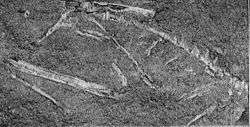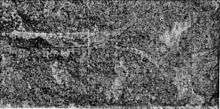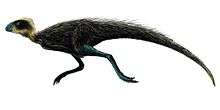Podokesaurus
| Podokesaurus Temporal range: Early Jurassic, 183 Ma | |
|---|---|
 | |
| Holotype specimen | |
| Scientific classification | |
| Kingdom: | Animalia |
| Phylum: | Chordata |
| Class: | Reptilia |
| Clade: | Dinosauria |
| Order: | Saurischia |
| Suborder: | Theropoda |
| Superfamily: | †Coelophysoidea |
| Family: | †Podokesauridae Huene, 1914 |
| Genus: | †Podokesaurus Talbot, 1911 |
| Species: | †P. holyokensis |
| Binomial name | |
| Podokesaurus holyokensis Talbot, 1911 | |
Podokesaurus ("swift-footed lizard") was a small carnivorous dinosaur that living during the Pliensbachian–Toarcian stages of the Early Jurassic Period, and as such is one of the earliest known dinosaurs to inhabit the eastern United States.[1]
Etymology
The generic name Podokesaurus is derived from Greek word podōkēs (ποδώκης) meaning "swift-footed", an epitheton often used by Homer in the Iliad to describe the hero Achilles, and saura (σαύρα) meaning "lizard"; thus "swift-footed lizard". The specific name refers to Holyoke, a city in Massachusetts, in the Connecticut River Valley.[2]
Description

The type specimen suggests that Podokesaurus was a small, bipedal carnivore was about 90 cm (3 ft) long and 0.3 m (1 ft) tall. Its upper leg bone (femur) measures 86 mm in length, and its lower leg bone (tibia) measures 104 mm in length. The tibia and other skeletal features of referred specimen BSNH 13656 (now on display at the Boston Museum of Science and given the number MOS 2001.248) are nearly three times longer than the type specimen described above. This suggests that Podokesaurus grew to about 9 feet in length, provided that BSNH 13656 is in fact an example of this genus.[3]
Discovery and occurrence

The only fossil of the type species Podokesaurus holyokensis, the full species name, was recovered in 1910 by Mount Holyoke College professor of geology and geography, Mignon Talbot. It consisted of a split boulder found by Talbot and her sister Elly on a hillock near to the college. The hillock consists of material deposited by ice and having its probable origin in the Portland Formation in Massachusetts. The slab and counterslab showed a poorly preserved, incomplete skeleton. Most of the skull is lacking. Talbot made pictures of the stones and sought advice from Richard Swann Lull, an authoritative dinosaur expert. It was formally described in June 1911 by Talbot herself, who thereby became the first woman to name a non-avian dinosaur.[4] Podokesaurus was originally thought to have lived during the Late Triassic Period, which was later disproved. Podokesaurus was discovered in sediments deposited during the Pliensbachian–Toarcian stages of the Early Jurassic Period, between 190 and 174 million years ago.

In 1958 a second specimen, BSNH 13656 (MOS 2001.248), was referred to P. holyokensis by Edwin Harris Colbert and Donald Baird. It consists of natural casts in sandstone of a pubis, tibia, three ribs, and a possible vertebra, probably collected in Middletown, Connecticut. The bone casts are from an individual about three times longer than the type specimen.[3] [5] The type, therefore, might have been a juvenile.

Classification

Because of the poor preservation of the original type material of Podokesaurus it is hard to find much difference when compared to the material of the much better known Coelophysis. From this Colbert concluded in 1964 that Podokesaurus was not a distinct genus but in fact a species of Coelophysis: Coelophysis holyokensis.[6] If so, it would by implication be a member of the Coelophysidae. However, the name Podokesaurus is still commonly used to refer to the material, while being assigned to a more general Coelophysoidea, as the identity is hard to prove and Coelophysis dates from a different period. The matter is complicated because all the original fossil material of Podokesaurus holyokensis was destroyed in a fire in 1917, and only casts remain, including those in the Division of Paleontology at the American Museum of Natural History in New York, the Peabody Museum of Natural History at Yale University, and the Amherst College Museum of Natural History (now the Beneski Museum).[7][8] Tykoski and Rowe noted that Podokesaurus likely possesses coelophysoid characters, but does not preserve any derived traits that would unite it with Coelophysis, thus Podokesaurus is a valid genus separate from Coelophysis. With respect to its taxonomic group, Podokesaurus has been assigned to Coelophysoidea incertae sedis by Tykoski and Rowe.[9]
Related genera
Podokesaurus shares the Coelophysidae taxon with Camposaurus and Coelophysis. It may also be related to Liliensternus, Procompsognathus, ?Pterospondylus, ?Segisaurus and ?Gojirasaurus.
Distinguishing anatomical features
A diagnosis is a statement of the anatomical features of an organism (or group) that collectively distinguish it from all other organisms. Some, but not all, of the features in a diagnosis are also autapomorphies. An autapomorphy is a distinctive anatomical feature that is unique to a given organism or group.
According to Colbert and Baird (1958), Podokesaurus can be distinguished from Coelophysis, and other dinosaurs based on the fact that neural spines on its dorsal vertebrae are anteroposteriorly shorter than those in Coelophysis bauri. Colbert and Baird (1958) also noted that a hip bone, the ischium, is "differently shaped" in Podokesaurus, when compared to Coelophysis, but did not describe how it was different.[3]
Paleobiology

The skull is virtually unknown in Podokesaurus but based on the available material which suggests placement in the family Coelophysidae, it can be assumed that it was a small carnivorous theropod, that likely preyed on animals smaller than itself. Based on its skelletal morphology it can be ascertained that Podokesaurus was bipedal and, contrary to early illustrations, ran with its tail extended and off the ground. It has been estimated that Podokesaurus could run at 14 – 19 km/h (9 - 12 mph), hence the name "swift-footed lizard".
See also
References
- ↑ "Podokesaurus". American Museum of Natural History. Retrieved 8 August 2013.
- ↑ Talbot, M., 1911, Podokesaurus holyokensis, a new dinosaur of the Connecticut Valley: American Journal of Science, v. 31, p. 469-479
- 1 2 3 Colbert E.H. and Baird, D., 1958, "Coelurosaur bone casts from the Connecticut Valley Triassic", Am. Mus. Novitates 1901: 1-11
- ↑ Turner, S., Burek, C. & Moody, R.T., 2010, "Forgotten women in an extinct Saurian 'mans' World", In: Moody, R.T., Buffetaut, E., Martill, D. & Naish, D. Eds. Dinosaurs and Other Extinct Saurians: A Historical Perspective. The Geological Society, London, Special Publication, 343: 111-153
- ↑ Getty, P. R.; Bush, A. M. (2011). "Sand pseudomorphs of dinosaur bones: Implications for (non-) preservation of tetrapod skeletal material in the Hartford Basin, USA". Palaeogeography, Palaeoclimatology, Palaeoecology. 302 (3–4): 407. doi:10.1016/j.palaeo.2011.01.029.
- ↑ Colbert, E.H. (1964) The Triassic dinosaur genera Podokesaurus and Coelophysis. Am. Mus. Novitates 2168: 1-12
- ↑ "Main Page". American Museum of Natural History. Retrieved 8 August 2013.
- ↑ "Main Page". Peabody Museum. Retrieved 8 August 2013.
- ↑ Tykoski, R.S. & Rowe, T. (2004). "Ceratosauria". In: Weishampel, D.B., Dodson, P., & Osmolska, H. (Eds.) The Dinosauria (2nd edition). Berkeley: University of California Press. Pp. 47–70
External links
- Coelophysis - relation to Late Triassic Coelophysis, from the Illinois State Geographical Survey
- Coelophysis - relation to Late Triassic Coelophysis, from the Natural History Museum of Los Angeles



